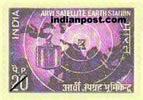| Postal Stamp Image |
: |
 |
| Stamp Issue Date |
: |
26/02/1972 |
| Postage Stamp Dinomination |
: |
0.20 |
| Postal Stamp Serial Number |
: |
0655 |
| Postal Stamp Name |
: |
MAP & SATELLITE |
| Stamp Information |
: |
The growth of rocketery and space technology during the course of the past decade has given mankind a new and powerful medium for global communication in the form of satellites. which can relay messages to and from the earth, with the help of the built-in receivers and transmitters. These satellites keep revolving round the earth once in 24 hours at a height of about 36000 kms over the equator, in step with the earth's rate of rotation on its axis. They thus appear, relatively, to be stationary from any point on the earth. One such satellite can cover nearly a third of the globe, while three of them suitably distributed can cover the entiree globe.
Unlike conventional hig frequency radio communication which works point to point, satelite link all stations in their area of coverage. This is possible on account of the wide-band capability od satellite radio relay systems.
Satellite permit voice, telegraphs radio-photo and data to be relayed with ease between stations in their area of coverage. They are also the only existing means of live transoceanic television. Already many historic events have been viewed live on television via satellite by millions of viewers in several continents.
Satellite communication is not subject to fading or atmospheric disturbances which are limitations of H.F. radio communications. It can provide the requisite high quality circuits to meet the challenging demands of ever-expanding international communications.
Satellite communications has verily opened up a new era of international cooperation which commenced with the setting up of Intelsat, the International Satellite Consortium, in 1964. This Consortium today has 77 member nations. India's participation in this international venture dates back to February, 1965 when its represantative signed at Washington the agreements of the International Consortium.
While the launching of the satellite and associated tracking and telemetering will be the responsibility of the Intelsat, each member country will be required to establish its earth station to work to the satellite. Accordingly a plan for the establishment of an Indian earth station and associated switching complex was drawn up as a part of the IVth Five Year Plan of Govt. of India for Oversease Communications Service, to provide the public with up-to-date facilities for international telecommunications, including international TV relay.
The earth station is located at Arvi about 80 kms north of Poona on the route to Nasik. This station works to the Indian Ocean Satellite, which is located over the equator at a nominal longitude of 61.4'E. The earth station has been inter-connected with Bombay by a broad-band microwave link across the Western Ghatts. Bombay serves as the gateway centre of the country for international telecommunications via satellite.
The main feature of the earth station is its large 29.6 meter diameter antenna, loking at the satellite is as low as a few wats and a large distance seperates the satellite from the earth station, very large size antennas are required to be used on ground. The same antenna is also used for transmitting to the satellite. The antenna dish at Arvi was manufactured in India.
Communication circuits have been established through Arvi earth station with Australia, Japan, East Africa, malaysia, and United Kingdom via satellite. Satellite circuits are extended to U.S.A. and Europe via U.K. Further extension to cover more earth stations via satellite is expected in due course.
The Indian Posts and Telegraphs department feel privilaged in bringing out a postage stamp to commemorate the first anniversary of the earth station Arvi, which is being dedicated to the nation by the President of India who is also releasing the commemorative stamp. The stamp depicts the "Globe Satellite" and the location of the earth station. This station is being named the Vikram Earth Station in memory of the late Dr. Vikram Sarabhai who was primarily responsible for the execution of this sophisticated project by Indian Engineers.
The First Day Cover being issued on this occasion bears a picture of the antenna at the earth station at Arvi. |
| Philatelic Stamp Description |
: |
DESCRIPTION OF DESIGN
The design of the stamp is horizontal and depicts "Global Satellite", the course od "Intesat III" in circular lines and 'Arvi Earth Station.' |
| Stamp Currency |
: |
P |
| Stamp Type |
: |
COMMEMORATIVE |
| Stamp Language |
: |
English |
| Stamp Overall Size |
: |
3.34 x 2.4 |
| Postal Stamp Print Size |
: |
2.99 x 2.1 cms. |
| Number of Stamps Per Sheet |
: |
54 |
| Stamp Perforations |
: |
14 x 13,1/ |
| Postal Stamp Shape |
: |
Diagonal |
| Postage Stamp Paper |
: |
Unwatermarked adhesive stamp paper |
| Indian Stamp Process |
: |
Photogravure |
| Number of stamps printed |
: |
30,00,000 |
| Stamp Printed At |
: |
India Security Press |
| Indian Stamp's Color |
: |
Gravure purple |
|
|
